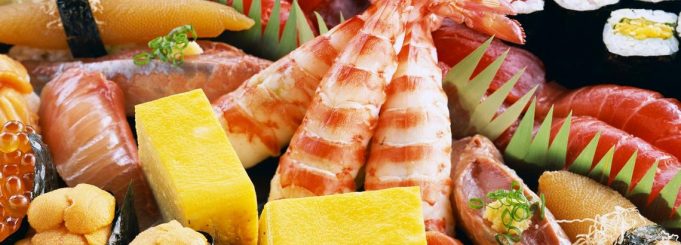Here, we live and breathe Japanese cuisine, so we’ve compiled a list of our top 30 recommendations for Japanese foods that you simply must try. Use the quick summary list below to choose which food to learn more about. Click your chosen food link and head off down the page to find out more.
If you like the look of any of these tasty dishes, then Japan Centre has some fantastic recipes for you to try. Click the link to find the recipe selection further down this page:
Must-Try Japanese Recipes
1.Sushi : Vinegared rice with tasty toppings.
2.Udon : Thick noodles in a savoury broth.
3.Tofu : Nutritious, versatile soy delight.
4.Tempura : Crispy, deep-fried seafood or veggies.
5.Yakitori : Juicy, grilled chicken skewers.
6.Sashimi : Fresh, delicate seafood slices.
7.Ramen : Flavourful, hearty noodle soup.
8.Donburi : Rice bowl with delicious toppings.
9.Natto : Unique, flavourful fermented soybeans.
10.Oden : Simmered, tasty one-pot dish.
11.Tamagoyaki : Sweet, fluffy layered omelette.
12.Soba : Refreshing buckwheat noodles.
13.Tonkatsu : Crispy, succulent pork cutlet.
14.Kashi Pan : Sweet-filled Japanese pastry.
15.Sukiyaki : Rich, sweet-savoury hot pot.
16.Miso Soup : Savoury soup with tofu and seaweed.
17.Okonomiyaki : Grilled savoury pancake with mix-ins.
18.Mentaiko : Savoury marinated cod roe topping.
19.Nikujaga : Hearty meat and potato stew.
20.Curry Rice : Mildly sweet curry over rice.
21.Unagi no Kabayaki : Sweet-glazed grilled eel on rice.
22.Shabu Shabu Hot Pot : Hotpot with sliced meat and veggies.
23,Onigiri : Rice balls with flavourful fillings.
24.Gyoza : Pan-fried meat and veggie dumplings.
25.Takoyaki : Octopus-filled savoury balls.
26.Kaiseki Ryori : Elegant multi-course Japanese meal.
27.Edamame : Steamed, salted young soybeans.
28.Yakisoba : Stir-fried noodles with sweet-savoury sauce.
29.Chawanmushi : Delicate steamed egg custard.
30.Wagashi : Traditional sweet treats with beans and fruits.
1. Sushi
Sushi is one of the first foods that spring to mind when we think about Japanese cuisine. This delicacy was one of the first Japanese dishes to be exported to the US after the Meiji Restoration in 1868, and since then its popularity has steadily increased year after year.
Sushi comes in various forms, including nigiri, maki rolls, and sashimi, with flavors ranging from mild to bold. Renowned for its balance of taste, texture, and presentation, sushi offers a delicious and healthy dining experience that celebrates the beauty of fresh, high-quality ingredients.
The word ‘sushi’ refers to any dish made with Japanese rice that has been seasoned with rice vinegar. Common varieties of sushi include makizushi (sushi rice and fillings rolled up in nori seaweed), nigiri sushi (shaped, bite-size mounds of sushi rice with single slices of raw fish or similar draped over the top) and inarizushi (sushi rice stuffed inside pockets of inari; a type of seasoned, fried tofu).
Recipe: How to make Sushi

2. Udon
One of the three main noodle varieties eaten in Japan; udon noodles are thick, chewy, and traditionally made from wheat flour and brine water.
Udon can be served in a number of different ways (mixed into stir fries, added to hot pots, served cold with a tsuyu or tentsuyu soup base on the side for dipping), but are most commonly used in noodle soups, where they are served in a savoury soup broth with different garnishes.
Hot udon is often served in a savory broth, typically made from dashi, soy sauce, and mirin, and can be accompanied by toppings like tempura, green onions, or tofu. Cold udon, popular in summer, is usually dipped in a light soy-based sauce. Whether in a hearty soup or a refreshing chilled dish, udon offers comfort and a satisfying, slurp-worthy experience.
Some of the most common udon noodle soup dishes include kitsune udon (‘fox udon’, topped with aburaage fried tofu), tempura udon (topped with tempura battered seafood and vegetables), and chikara udon (‘power udon’, topped with grilled mochi rice cakes).
Recipe: How to make Tanuki Udon
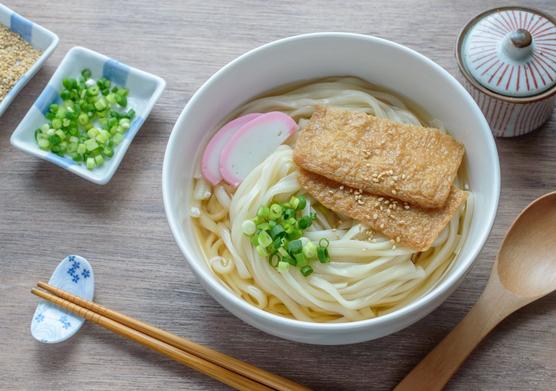
3. Tofu
Although tofu is mainly thought of in Western countries as a health food or vegetarian alternative, in Southeast Asian countries like Japan, tofu (particularly silken tofu) is enjoyed by everybody and is a common part of the traditional diet.
Tofu is rich in protein and low in calories, making it a popular choice for vegetarians and those seeking plant-based alternatives. It can be prepared in various ways—stir-fried, grilled, steamed, or added to soups and salads. Because it absorbs the flavors of whatever it’s cooked with, tofu is a favorite ingredient in both savory and sweet dishes across many cultures.
To answer the question ‘what is tofu?’, it is soy milk that has been coagulated, with the resulting curds being pressed into blocks. These blocks come in differing levels of firmness, and can be eaten uncooked (perhaps with a couple of savoury garnishes), boiled in hot pots, or fried into tasty pieces of aburaage and used as a garnish.
Recipe: How to make Hiyayakko Chilled Tofu

4. Tempura
If you enjoy crispy fried foods, then you will love tempura. Tempura are pieces or slices of meat, fish, and/or vegetables that have been covered in a special tempura batter and deep fried until they become crunchy and pale gold in colour.
The batter, made from flour, water, and sometimes egg, creates a delicate, airy coating that enhances the natural flavors of the ingredients without overwhelming them. Tempura is often served with a dipping sauce made from soy sauce, dashi, and mirin, and accompanied by grated daikon radish. Known for its crunch and subtle taste, tempura offers a delightful balance of texture and flavor in every bite.
Unlike in the UK, where battered foods tend to be made from meats and fish, tempura tends to be made from either small shellfish like prawns, or vegetables like green beans, pumpkin, daikon mooli radish, and sweet potato. Tempura can be eaten by itself (perhaps with a little grated daikon and a small dish of tsuyu for dipping), or served on top of rice bowls or noodle soups.
Recipe: How to make Tempura
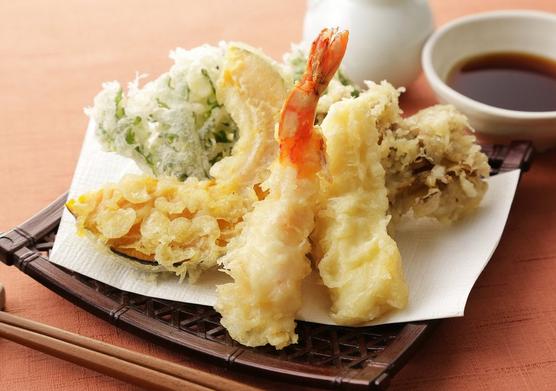
5. Yakitori
While we in the UK might pick up a serving of chips or a hot dog during a sports match, the Japanese will pick up some yakitori. With a name literally meaning ‘barbecued chicken’, yakitori are small skewers of bite-size chicken pieces seasoned with salt or brushed with a sauce, or tare, of mirin rice wine, soy sauce, sake alcohol, and sugar.
The chicken, cut into bite-sized pieces, is typically seasoned with either a salty-sweet tare sauce or simply with salt. Yakitori skewers can include various parts of the chicken, such as thighs, wings, and even chicken hearts or liver, offering a variety of textures and flavors. Cooked over a charcoal grill, yakitori has a smoky, savory taste and is often enjoyed with a cold drink, making it a beloved comfort food in Japan.
There are many different types of yakitori, but the most common varieties are momo (chicken thigh), negima (chicken and spring onion), and tsukune (chicken meatballs).
Recipe: How to make Yakitori
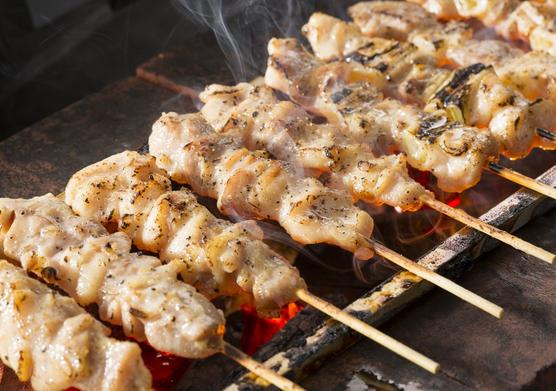
6. Sashimi
Possibly one of the most controversial dishes in all of Japanese cuisine, sashimi is raw fish or meat that has been expertly cut into thin slices and typically comes served with daikon radish, pickled ginger, wasabi and soy sauce.
Often accompanied by soy sauce, wasabi, and garnishes like daikon radish or shiso leaves, sashimi is a refined culinary experience that emphasizes quality. It requires precise knife skills to achieve the perfect cut, making it not only a delicious dish but also a visually beautiful one.
Sashimi differs from sushi in that all sushi is made with vinegared rice and does not always contain raw fish, while sashimi is almost exclusively raw fish and is never served with rice. The fish used to make sashimi must be as fresh as possible, both in order to minimise the risk of contamination, and because fresher fish makes for tastier sashimi.
Recipe: How to make Sashimi

7. Ramen
Ramen is a noodle soup dish consisting of wheat noodles (also known as ’ramen noodles’), a savoury broth (soy sauce, salt, miso, and tonkotsu pork bone are the four main ramen broth bases) and toppings of meat, protein, and/or vegetables such as sliced pork, nori seaweed, spring onions, bamboo shoots, and others.
Ramen is often topped with a variety of ingredients, such as sliced pork (chashu), soft-boiled eggs, nori, green onions, and bamboo shoots. Each region in Japan has its own unique style of ramen, making it a versatile and customizable dish that offers a warm, satisfying meal with layers of flavor in every bowl.
Ramen is one of present-day Japan’s absolute favourite delicacies, costing very little and being widely available in restaurants and ramen bars (which are on almost every street corner). Indeed, Japanese ramen is so popular that there is a ramen-themed museum/amusement park in Tokyo.
Recipe: How to make Ramen
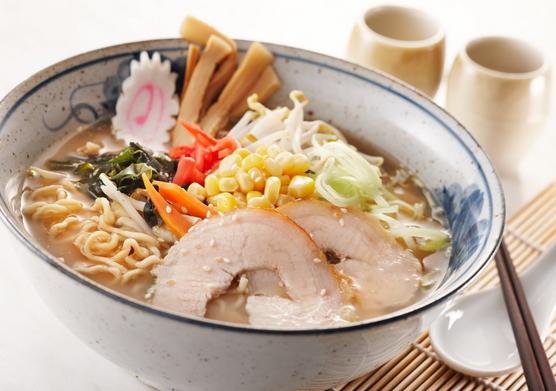
8. Donburi
This rice bowl dish is almost as popular as ramen in Japan and a common lunchtime choice among busy Japanese workers. Donburi is made by preparing (normally by simmering or frying) various meat, fish and vegetables and serving over steamed rice in large bowls (also called ‘donburi’).
Donburi is known for its hearty, comforting quality, often flavored with sauces like soy sauce, mirin, and dashi to enhance the ingredients. Each donburi variation offers a unique combination of flavors and textures, making it a satisfying meal that’s simple yet delicious. It’s a popular choice for a quick and filling meal in Japan.
While donburi can be made using just about any assortment of ingredients, the most common types include oyakodon (simmered chicken, egg, and green onion), gyudon (sliced beef and onion simmered in a soy sauce soup base), tendon (fried tempura pieces drizzled in tsuyu), and katsudon (breaded and deep-fried pork cutlets, or tonkatsu, simmered in tsuyu with onion and egg).
Recipe: How to make Donburi
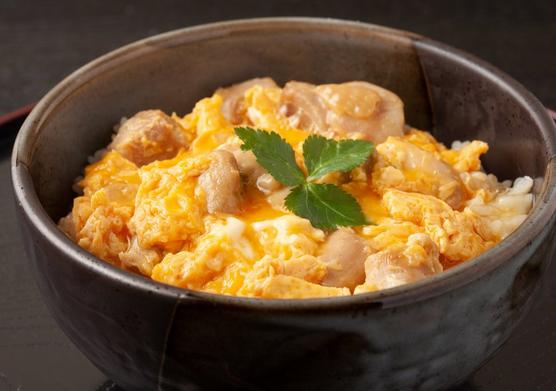
9. Natto
In the same way that Marmite divides the British nation, so too does natto divide the Japanese. This traditional Japanese food is made by fermenting soy beans in a special type of bacteria that is naturally produced in the human gastrointestinal tract.
Natto has a strong smell similar to mouldy cheese, as well as a sticky/slimy texture that many find off-putting. However, many other people love these fermented soy beans for their full-bodied salty and savoury (or umami) flavour and their ample nutritional value. Is natto delicious or disgusting? It is up to you to decide.
Recipe: How to make Natto Breakfast Bowl
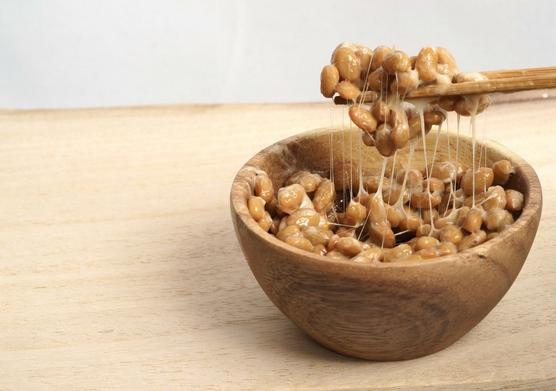
10. Oden
No cold Japanese winter would be complete without oden. This winter hot pot dish, or nabemono, is made by taking an assortment of vegetables and proteins (including processed fish cakes, mochi rice cakes, boiled eggs, daikon radish, konjac yam and tofu), and stewing them in a light broth seasoned with soy sauce and dashi (a soup stock made from infusions of bonito fish flakes, kombu kelp seaweed, and/or other savoury ingredients) in a large hot pot at the centre of a table.
Diners can then scoop out their favourite pieces and enjoy with karashi mustard and other condiments. As well as being a hearty main meal, the simmering hot pot also serves as a communal heater on cold evenings.
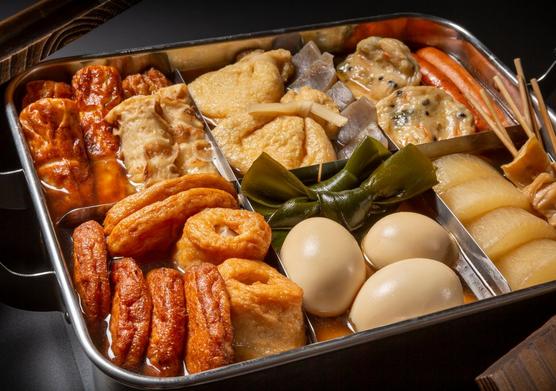
11. Tamagoyaki
A versatile delicacy that can be enjoyed for breakfast, lunch, or dinner, tamagoyaki (which literally means ‘cooked egg’) is a Japanese omelette made by sequentially cooking and rolling up several layers of beaten egg (sometimes seasoned with soy sauce and/or sugar).
A freshly cooked tamagoyaki looks like a rolled up crêpe, which can then be sliced up and eaten by itself (often this is how it is eaten at breakfast) or used a topping or filling in sushi. A tamagoyaki-topped nigiri sushi is often eaten in sushi bars as the final course, as the tamagoyaki has a slight sweetness that makes it almost dessert-like.
Recipe: How to make Tamakoyaki
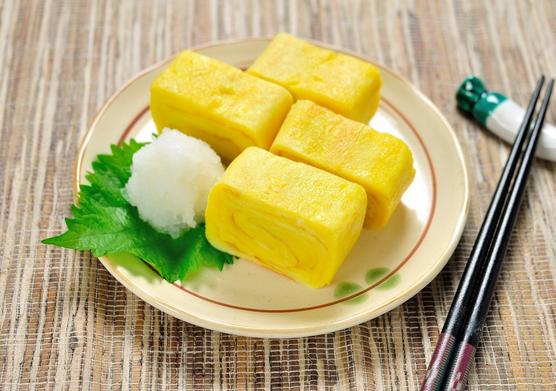
12. Soba
Otherwise known as ‘buckwheat noodles’ (‘soba’ is the Japanese word for ‘buckwheat’), soba are one of the three main varieties of noodle most frequently eaten in Japan. Unlike udon and ramen; soba noodles are made partially, if not entirely, from buckwheat flour. This gives them a distinctly earthy and slightly nutty flavour that works well with stronger flavours like garlic and sesame.
Soba can be served hot in soups with toppings of spring onions, agetama tempura flakes, kamaboko fish cakes and/or grilled mochi), or cold with a side of tsuyu and garnishes of green onions, shredded nori seaweed, and wasabi.
Recipe: How to make Soba noodles

13. Tonkatsu
Tonkatsu pork cutlets are one of the many yoshoku, or ‘western-style’ foods, that were originally introduced to Japan by Europeans. Like most other yoshoku foods, the Japanese took the original tonkatsu and made it their own.
Today, tonkatsu is made by coating pork chops in crisp panko breadcrumbs and deep-frying them until they are golden brown in colour. They are normally served drizzled in fruit-and-vegetable based tonkatsu sauce with shredded cabbage and other crisp salad greens on the side. Tonkatsu are also often enjoyed as part of a bento boxed lunch, in a Japanese curry (known as ’katsu curry’), or as a sandwich filling.
Recipe: How to make Tonkatsu
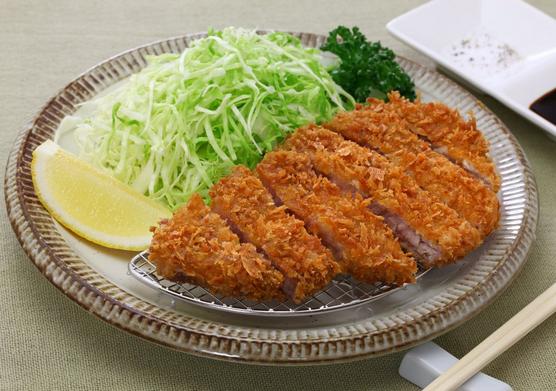
14. Kashi Pan
The Japanese love a good bread roll as much as the next person, and bakeries line Japan’s city streets with almost as much regularity as ramen bars. The word ‘kashipan’ means ‘sweet bread’, and it refers to a range of single-serve bread buns that were originally invented in Japan.
Among the most popular of these are melon pan (a bread bun with a cookie dough top), an pan (a bread bun filled with an or anko; a sweet red bean paste), and karee pan or kare pan (a bread bun filled with curry sauce, covered in panko breadcrumbs, and deep-fried). Kashipan are a must-try for bread lovers in particular.
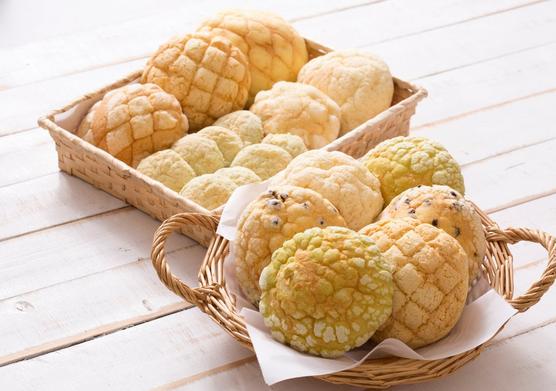
15. Sukiyaki
Like oden, sukiyaki is a Japanese nabemono hot pot dish most commonly enjoyed during the winter. Sukiyaki hot pots are prepared by searing beef slices in the hot pot, then adding sukiyaki broth (normally made from soy sauce, sake, mirin rice wine and sugar) and different vegetables, noodles, and proteins.
The name ‘sukiyaki’ means ‘cook what you like’, and the joy of sukiyaki comes from being able to prepare the dish with your fellow diners, at the table, using whatever ingredients you desire.
Recipe: How to make Sukiyaki

16. Miso Soup
Few Japanese dishes are consumed more often or more consistently than miso soup. Made from a combination of miso paste (a traditional Japanese food made from fermented soy beans) and dashi broth, miso soup is served as a side dish with traditional Japanese-style breakfasts, lunches and dinners.
The complex savoury flavours of the soup help to enhance the umami of the main dishes with which it is served. To give the miso soup a little more body, several complementary toppings are normally added to it, such as green onion, wakame seaweed, and firm tofu.
Recipe: How to make Miso Soup

17. Okonomiyaki
Okonomiyaki is made by mixing together batter, sliced cabbage, and other savoury ingredients; spooning the mixture onto a hot plate; and then pan-frying as you would a pancake. Okonomiyaki originated in Osaka and Hiroshima (where a different, ‘layered’ style of okonomiyaki exists) and its popularity spread to the rest of Japan, where specialised okonomiyaki restaurants are easy to come by.
In some of these restaurants you can cook the okonomiyaki yourself, which makes for a delightfully fun cooking experience.
Recipe: How to make Okonomiyaki

18. Mentaiko
Lovers of salty seafood will reach the peak of their desires with mentaiko. This salty delicacy is made by marinating the roe (fish eggs) of pollock and cod in any of a number of salty, savoury, and spicy seasonings. The most basic mentaiko is marinated in a simple salt solution, while mentaiko marinated in spicy chilli pepper (known as ‘karashi mentaiko’) is becoming increasingly popular.
Mentaiko is traditionally eaten as a side dish with steamed rice, as a topping on ramen, or as a filling in onigiri rice balls. In recent decades mentaiko has also been mixed with butter or cream to make a simple savoury or spicy mentaiko pasta sauce.

19. Nikujaga
A flavoursome savoury dish of meat, potatoes and assorted vegetables simmered in soy sauce, sake, mirin and sugar, Nikujaga meat and potato stew is one of a collection of Japanese dishes called ‘nimono’ (meaning ‘simmered things’).
Although nikujaga is available in plenty of Japanese restaurants, it is also considered a homely dish that differs in flavour from household to household. For an authentic Japanese nikujaga experience, therefore, the best thing to do is get invited to a Japanese friend’s house and put in a request with the family chef.
Recipe: How to make Nikujaga

20. Curry Rice
Known in Japanese as kare or kare raisu, Japanese curry is a yoshoku dish that was originally introduced to the Japanese by the British during the Meiji era (1868-1912).Japanese curry differs from the Indian varieties with which the UK is more familiar, in that it is generally sweeter in flavour, thicker in texture, and prepared more like a stew (with meat and vegetables being cooked by boiling in water together).
Japanese curry is often prepared in Japanese homes with the help of curry roux; blocks of solidified Japanese curry paste that melt into the ‘stew’ and thicken up to become a flavoursome curry sauce.
Recipe: How to make Curry

21. Unagi no Kabayaki
‘Unagi’ is the Japanese word for ‘freshwater eel’, and unagi no kabayaki is one popular unagi dish that dates back to the Edo period (1603-1868), when Japanese people customarily ate kabayaki unagi during the summer in order to gain stamina.
Unagi no kabayaki is made by brushing prepared eel fillets with a sweetened soy sauce-based kabayaki sauce and broiling them on a grill.
The name ‘kabayaki’ refers to this method of cooking, and it can also be done with some other types of fish, including catfish. However, if you are in Japan during the summer, use the opportunity to try the genuine article.
Recipe: How to make Unagi no Kabayaki

22. Shabu shabu hot pot
Shabushabu is a nabemono hot pot dish similar to sukiyaki, made by boiling vegetables, tofu and other ingredients in a mellow broth seasoned with kombu kelp, and then dipping very thin slices of meat into the broth and swishing the meat around until it cooks (normally around 10-20 seconds).
This meat is then dipped in a ponzu citrus seasoned soy sauce or sesame sauce before being eaten with some of the other boiled ingredients.
The name ‘shabu shabu’ is an onomatopoeia word for the noise the meat slices make as they are swished around.
Recipe: How to make Shabu Shabu hot pot

23. Onigiri
Like the sandwich could be considered the original portable food of British cuisine, the onigiri rice ball is the original portable food of Japan.
Also known as ‘omusubi’, ‘nigirimeshi’, or just ‘rice balls’, onigiri are portions of Japanese rice, normally with a filling in the centre, that have been moulded into triangular or cylindrical shapes before being wrapped in nori seaweed.
Onigiri have been enjoyed in Japan for hundreds of years, and most Japanese convenience stores nowadays sell a great range of onigiri for 100-150 yen (£0.75-£1.12) a piece. Popular onigiri fillings include umeboshi pickled plums, seasoned seaweed, tuna mayonnaise, and teriyaki chicken.
Recipe: How to make Onigiri

24. Gyoza
Gyoza are savoury moon-shaped dumplings, made from a minced mixture of savoury fillings (pork mince, cabbage, green onion and mushroom is a common combination, but other fillings can be used as well) which are wrapped up in a circular gyoza wrapper and crimped or pleated around the edges to make an iconic half-moon shape.
Gyoza dumplings are normally cooked by frying on one side (a process that gives the gyoza a crisp, savoury bottom), and then steaming for 2-3 minutes so that the rest of the rest of the wrapper is smooth and silky, and the filling inside is moist and juicy.
Recipe: How to make Gyoza

25. Takoyaki
As far as Japanese street vendor foods are concerned, few are more notorious than takoyaki. Also known as ‘octopus balls’ or ‘octopus dumplings’, this delicacy is cooked using a special hot plate with rows of half-spherical moulds. Each of the moulds is filled with a savoury batter mixture before a bite-size piece of tako octopus meat is inserted into the middle. The takoyaki are turned with a pick or skewer every minute or so to ensure an evenly-cooked outside and a perfect ball-shaped dumpling in the end.
Takoyaki are typically served in lots of six, eight or ten, brushed with a sweet/savoury takoyaki sauce and topped with mayonnaise, aonori seaweed and katsuobushi bonito fish flakes.
Recipe: How to make Takoyaki

26. Kaiseki Ryori
If you are hoping to experience the Japanese equivalent of haute cuisine, then you need to try kaiseki ryori. Also known simply as ‘kaiseki’, kaiseki ryori are traditional, multi-course Japanese dinners.
A full kaiseki can involve a dozen or more different dishes made with fresh, seasonal, and/or local produce, each prepared in very small servings and in such a way as to enhance the produce’s natural flavour. The courses in kaiseki all demonstrate a different cooking technique, and the complete experience is seen in Japan as an artform as much as a sit-down dinner.
Kaiseki can normally be enjoyed in specialised restaurants or at ryokan (Japanese-style inns).
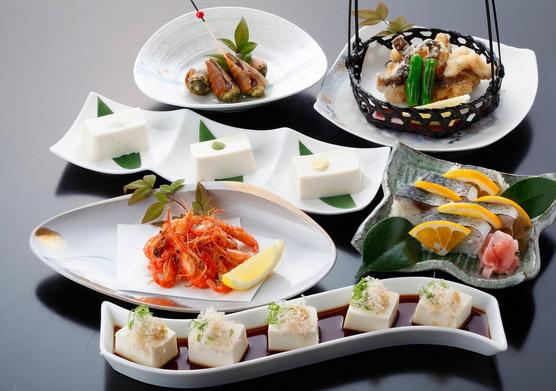
27. Edamame
While frequent pub-goers in the UK like to snack on peanuts and pork scratchings with their lagers, the regulars in Japan’s izakaya pubs enjoy freshly prepared edamame.
These bright green, immature soy beans, harvested before the beans have hardened, are normally served in the pod after being blanched and lightly salted. As well as boasting a naturally delicious and mellow umami flavour that works beautifully with light salt seasonings, edamame beans also carry a number of health benefits (being naturally high in protein, iron, and calcium).
Edamame are often served in pubs and restaurants as a complimentary appetiser.
Recipe: How to make Spicy edamame

28. Yakisoba
It is virtually impossible to attend a summer festival in Japan and not come across a yakisoba stand.
Yakisoba is a fried noodle dish made by barbecuing or stir-frying a combination of noodles, sliced cabbage, pork, carrot and other vegetables, and a barbecue style yakisoba sauce. During the summer festivals large piles of these ingredients are thrown onto an outdoor hotplate and barbecued, but yakisoba can also easily be made at home using a large frying pan or wok.
‘Yakisoba’ means ‘cooked soba’, but unlike other soba noodles, the noodles used in yakisoba do not contain any buckwheat.
Recipe: How to make Yakisoba

29. Chawanmushi
As far as mellow, comforting, and uniquely Japanese dishes are concerned, chawanmushi is one of the best.
This steamed, savoury egg custard is made by pouring seasoned, beaten eggs into individual cups already filled with different meats and vegetables (including chicken, mushrooms, gingko nuts, kamaboko fish cakes, and carrots), and then steaming the cups in a pot or steamer until they have solidified and become similar to pudding in texture.
Chawanmushi gets its name by combining the words ‘chawan’ (meaning ‘teacup’)and ‘mushi’ (meaning ‘steamed’), so chawanmushi is, literally, ‘steamed in a cup’.

30. Wagashi
The most authentic way to finish off a Japanese meal or matcha tea ceremony is with wagashi.
Wagashi are traditional Japanese sweets, invented during the Edo period and influenced by prevalent Japanese ingredients and flavours. Most wagashi are made using only a handful of select ingredients, including mochi rice cakes, anko paste, kanten (agar; a vegetarian thickener similar to gelatine), chestnuts, and sugar.
The most popular wagashi include dango (sweet mochi balls on skewered sticks, often served with sugar syrup), daifuku (mochi rice stuffed with anko), dorayaki (anko sandwiched between two thick pancakes), and yokan (blocks of anko hardened with kanten and sugar).
Recipe: How to make Wagashi

Discovering Japan’s Culinary Treasures
The roots of Japanese cooking are steeped in a philosophy that balances taste, texture, and presentation—a philosophy that has evolved through the ages under the influence of both internal developments and external contacts, such as with China and the West.
For instance, the adoption of Buddhism in the sixth century led to a decrease in meat consumption, paving the way for a predominantly pescatarian diet that still characterises much of the nation’s diet today. Additionally, the introduction of rice cultivation has shaped much of Japan’s agricultural and culinary landscape, making rice a staple at most meals.
Culinary skills in Japan are passed down through generations, often within families who have honed their craft over centuries, and through rigorous professional apprenticeships that emphasise precision and patience. The result is a cuisine that is also an art form, where chefs spend years mastering the exacting techniques required to perfect dishes such as sushi and ramen.
Breakfast in Japan: A Healthy Start
In stark contrast to the often heavy, greasy breakfasts common in the UK and the sugary starts typical in the US, the traditional Japanese breakfast is a testament to the cuisine’s overarching commitment to health and balance. Typically, a Japanese morning meal is a varied spread that includes several small dishes: grilled fish, rice, pickled vegetables, and a bowl of miso soup. Each component is chosen for its nutritional value and ability to harmonise with the overall meal.
The cornerstone of the breakfast, miso soup, exemplifies the health-centric ethos of Japanese cuisine. Made from fermented soybean paste, it is rich in essential minerals and probiotics, which aid digestion and boost the immune system. Natto, another fermented soy product featured at breakfast, is packed with protein and a powerful enzyme called nattokinase, which is known to help prevent blood clots.
This emphasis on a balanced diet from the start of the day contrasts sharply with the sometimes-indulgent breakfast practices elsewhere. In the UK, a traditional fry-up often includes bacon, sausages, eggs, and baked beans, while in the US, pancakes, waffles, and syrup-laden dishes dominate many breakfast tables. These meals typically contain higher levels of processed sugars and fats, whereas the Japanese breakfast focuses on whole, unprocessed foods that contribute to the renowned longevity of its people.
Signature Dishes: The Pillars of Japanese Cuisine
From the delicate flavours of sashimi to the comforting warmth of a noodle soup, Japan’s signature dishes are a broad showcase of the country’s regional diversity and culinary expertise.
Sushi, perhaps Japan’s most famous culinary export, varies significantly from region to region. In Tokyo, the nigiri style—a slice of fish over a mound of vinegared rice—prevails, while in Osaka, sushi tends to be pressed and includes a variety of ingredients like vinegared mackerel.
Ramen, another beloved dish, demonstrates how regional preferences shape food culture. Tokyo’s version boasts a soy-flavoured chicken broth, while Sapporo, in the north, is known for its rich, miso-based broths that cater to colder climates. Further south, Fukuoka is famed for its tonkotsu ramen, featuring a broth made from pork bones simmered for hours to a creamy consistency.
The adaptability of these dishes to local preferences and ingredients not only makes them enduringly popular but also mirrors the dynamic nature of Japanese cuisine, which has continually evolved while maintaining a distinct culinary identity.
Dining Etiquette and Experience: Eating Out in Japan
Eating out in Japan is an experience steeped in tradition, yet dynamic and diverse. From the fast-paced sushi bars where chefs craft pieces before your eyes to the serene settings of a kaiseki meal where each dish is a work of art, the dining experience is integral to Japanese culture.
In traditional settings like izakayas, which are like casual dining pubs, the atmosphere is as important as the food. These establishments often serve as places for communal bonding and leisurely dining, featuring an array of dishes that encourage sharing and interaction. Common practices, such as pouring sake for one another, enhance the communal feel and show respect among diners.

